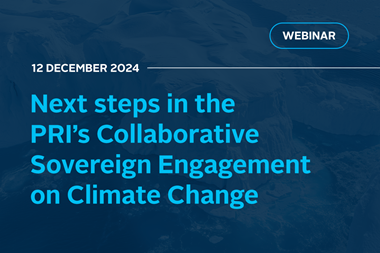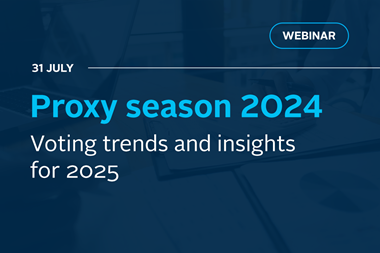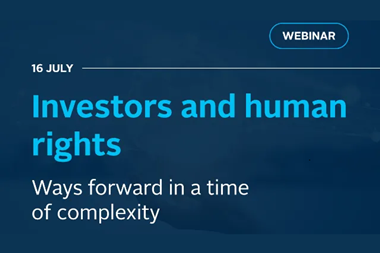Once they have completed the policy-setting process, asset owners can use the investment mandate to communicate their expectations for ESG integration across a portfolio. Proceeding to manager selection, appointment and monitoring without addressing ESG factors in mandates is a common – but easily remedied – oversight.
Informed by interviews with asset owners and investment consultants, and data on industry practice, this report outlines common approaches and challenges to incorporating ESG considerations and sustainability outcomes in new or existing investment mandates.
PRI data gathered from a broad and geographically diverse asset owner base reveal that asset owners increasingly incorporate ESG policy expectations into contractual documentation, with investment mandates proving to be an exception. This finding is in line with the higher profile of ESG considerations in the relationship between asset owners and asset managers. Our research shows that this shift is attributable to changes in regulation, increasing interest from beneficiaries, evidence on investment returns and an increasing interest in incorporating sustainability outcomes.
Common approaches
Incorporating ESG into mandate design is a different process for new and existing mandates, according to the interviews undertaken for this report. In both cases, asset owners outlined discrete steps to set expectations, collect data, evaluate performance and review decisions.
Existing mandates
As an asset owner’s responsible investment policy evolves, existing mandates governing the asset owner-manager relationship will need to reflect any new priorities or objectives. Re-drafting the mandate or the investment management agreement (IMA) entirely may be a costly exercise, so existing mandates are often adapted through two key actions:
Updating expectations: Expectations for ESG requirements and sustainability outcomes are formally written into existing documentation.
Ongoing monitoring: Managers report on their ESG performance to the asset owner using various frameworks.
New mandates
Though issued less frequently, new mandates can include expectations around ESG integration and sustainability outcomes. These may be incorporated as mandatory requirements, optional features or performance targets. The steps to integrate ESG factors into new mandates include:
Outlining expectations: Minimum responsible investment expectations or standards are set out. Expectations might include certain practices or reporting requirements.
Data collection: Qualitative and quantitative information about managers’ ESG practices is gathered.
Manager analysis: The selection process includes building a roster of potential asset manager candidates that offer strategies aligned with the asset owner’s mandate.
For both approaches, continuous review and evaluation of practices allow asset owners to assess whether an investment manager meets the requirements laid out in the mandate and inform future mandate design.
Industry evidence[1] shows that asset owners’ and beneficiaries’ interest in seeking sustainability outcomes has been growing. To align sustainability outcomes with investment mandates, asset owners are increasingly focusing on the UN Sustainable Development Goals (SDGs), on setting targets, and on outcomes.
Challenges
Research for this report highlighted a range of challenges asset owners face when integrating ESG risks and sustainability outcomes into mandates:
- ESG performance and risk attribution
- Consistency with fiduciary duty
- Transparency
- Sufficient length of investment manager track record
- Limits posed by pooled or co-mingled funds
- Benchmark selection
- Insufficient educational collateral
Next steps
In light of this research and discussions with PRI’s Asset Owner Technical Advisory Committee, two practical next steps emerged to address some of the reported challenges:
- Encourage and facilitate alignment of approaches to developing investment mandates: Integrating ESG considerations in mandate design remains an ad hoc and potentially time-consuming process. Enabling and facilitating the development of standard elements to be incorporated within mandate design should increase uptake by asset managers. PRI’s report on manager appointment outlines topics that might be covered within future mandate design.
- Promote awareness among key stakeholders: Not all asset owners will have the leverage needed to persuade asset managers to implement ESG expectations and sustainability outcomes within investment mandates. Coordination among asset owners to set minimum ESG integration and sustainability outcome expectations could help asset managers develop the relevant competencies and meet asset owner expectations.
About this paper
This report explores to what extent asset owners consider ESG factors when developing and designing investment mandates. It highlights current market practices and barriers to incorporating ESG factors in mandate design and adds to the PRI’s existing work on behalf of asset owners – especially recent guidance on the selection, appointment and monitoring of asset managers.
The report will be of particular interest to trustees and those with responsibility for governance of asset pools in public and corporate pension schemes, endowments, trusts and family offices. The report will also be relevant to both asset owners already employing ESG-themed strategies and those newer to responsible investment approaches. The information presented here has been informed by interviews with 15 asset owners and consultants from North America, Europe and Australasia who kindly shared their approaches to integrating ESG in their investment mandates. Though each interviewee comes from a specific regional context, the report is intended to be of value in any geographic region (please see Acknowledgements for a list of participants and Appendix for the questionnaire).
The interviews were conducted in Spring 2021. The report’s findings and commentary also rely on indicative information gathered from signatories through three webinars on manager selection, appointment and monitoring hosted by the PRI. This report was compiled by Wilshire, Sustfin and PRI between April and June 2021. The recommendations are those of the PRI; they should not be interpreted as representing views of the contributors or individual PRI signatories.
The five modules of the PRI asset owner programme are designed to reflect five steps in the asset owner decision process (see Figure 1). The review undertaken for this report has shown that asset owners tend to jump straight from incorporating ESG in their investment policies (Module 1) to assessing the quality of ESG integration during investment manager selection, appointment and monitoring (Modules 3, 4 and 5). This report addresses the missing step, integrating ESG in investment mandate design (Module 2).
Figure 1: The PRI asset owner programme. Source: PRI
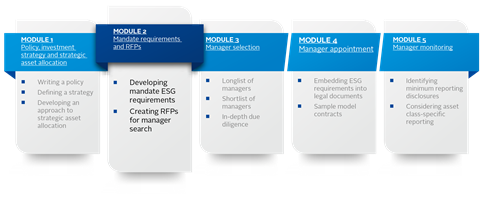
Market overview
Key messages:
- The incorporation of ESG policies into the investment process is widespread among PRI signatories and takes a variety of forms.
- Growing attention to ESG factors is driven by a changing regulatory environment, increased interest among beneficiaries, investment returns, and a focus on sustainability.
Evidence gathered from our signatories through the PRI Leaders’ Group and Reporting Framework shows that incorporating ESG-related policies and practices in the selection of asset managers is now widespread. A large majority of signatories include an assessment of culture, ESG policy, training and capacity, exclusions requirements and governance structures in the selection of investment managers.[2] In addition, including ESG policy expectations in contractual documentation, such as legal agreements, has now been undertaken by an increasing number of asset owner signatories on all or a majority of their assets.[3]
Industry data also show that a sizeable minority of signatories are now comfortable tracking positive and negative sustainability outcomes of their activities on all or a majority of their assets under management (AUM).[4]
However incorporation of ESG factors into investment mandates has lagged other responsible investment practices. To address this gap, the PRI commissioned research on leading practices among asset owner signatories who are incorporating ESG considerations into their relationships with asset managers, including through investment mandates. The findings mirror practices identified in earlier PRI research (see Figure 2). In response to increasing interest in sustainability outcomes, PRI’s recent framework on sustainability outcomes articulates the need for asset managers to assess negative and positive sustainability outcomes.
Figure 2: Range of approaches
| CONSIDERING ESG ISSUES WHEN BUILDING A PORTFOLIO (known as: ESG incorporation) | IMPROVING ESG PRACTICES, OUTCOMES AND DISCLOSURE (known as: active ownership or stewardship) | |||
|---|---|---|---|---|
ESG issues can be incorporated into existing portfolio construction practices using a combination of three approaches: integration, screening and thematic. |
Investors can encourage the companies they are already invested in to improve their ESG risk management or develop more sustainable business practices. |
|||
| Integration | Screening | Thematic | Engagement | Voting |
| Explicitly and systematically including ESG issues in investment analysis and decisions, to better manage risks and improve returns. | Applying filters to lists of potential investments to rule companies in or out of contention for investment, based on an investor’s preferences, values or ethics. | Seeking to combine attractive riskreturn profiles with an intention to contribute to a specific environmental or social outcome. Includes impact investing. | Interactions between an investor and current or potential investees/ issuers, in order to: improve practice on an ESG issue, change a sustainability outcome in the real world or improve public disclosure. Engagement can also be with non-issuers, such as policy makers or standard setters. | Exercise voting rights on management/shareholder resolutions (and submitting resolutions), to formally express approval (or disapproval) on relevant matters. |
| Sustainability Outcomes | ||||
| Shaping outcomes in line with planetary goals and thresholds such as the UN Sustainable Development Goals and the Paris Agreement | ||||
Whichever approach is followed, the responsible investment policy or statement is the vehicle for framing the relationship between an asset owner and asset manager. As part of the Reporting Framework, the PRI has collected more than 1,500 responsible investment policy statements from signatories.
A review of policies in the PRI Responsible Investment Policy Database found key features that are relevant to the design of investment mandates. For instance, many large and small asset owners have started to incorporate frameworks such as the SDGs and the UN Global Compact within their responsible investment policies. While these policies tend to outline intent rather than detailed processes, some leading asset owners set clear expectations of third-party managers and explain how these expectations are handled. Some describe how these policies influence asset allocation, with links to the SDGs and the Paris Agreement clearly articulated. Many now cover impact reporting, interaction with consumers, commitments to greater levels of transparency and meeting challenges such as net-zero commitments or Paris-aligned portfolios.
Drivers for integrating ESG into mandates
Our research highlighted four factors that are driving increased incorporation of ESG considerations in the relationship between asset owners and asset managers. These include regulation, beneficiaries, investment returns and sustainability outcomes.
-
Regulation
The recent rapid growth[5] of legislation governing responsible investment practices is being driven by international bodies, national governments and smaller public jurisdictions. For example, the state of Illinois has adopted a far-reaching approach to regulation relating to the management of public funds.
Read the questionnaire from Illinois Sustainable Investing Act
The Sustainable Investing Act (PA 101-473) was spearheaded by Illinois Treasurer Frerichs and signed into law by Illinois Governor Pritzker with an effective date of January 1, 2020. It provides that all state and local government entities that hold and manage public funds should integrate material, relevant, and useful sustainability factors into their policies, processes, and decision-making.
“The Office of the Illinois State Treasurer (‘the Treasurer’)… has a responsibility to recognise and evaluate risk and opportunity factors that may have a material and relevant financial impact on the safety and/or performance of our investments.
“Thus, consistent with achieving the investment objectives set forth herein, the Treasurer and its agents shall prudently integrate sustainability factors into its investment decision-making, investment analysis, portfolio construction, due diligence and investment ownership in furtherance of the Treasurer’s investment goals to fulfil its fiduciary duty, to maximise anticipated financial returns, and minimise projected risk.
“Sustainability factors shall be implemented within a framework predicated on the prudent integration of material sustainability factors, including, but not limited to (1) environmental, (2) social capital, (3) human capital, (4) business model and innovation, and (5) leadership and
governance factors, as components of portfolio construction, investment decision-making, investment analysis and due diligence, prospective value proposition, risk management, and investment ownership, given that these tangible and intangible factors may have material and relevant financial impacts….”
Michael W. Frerichs - Illinois State Treasurer: Sustainable Investing Act (illinoistreasurer.gov)
-
Beneficiaries
Beneficiaries are also increasingly interested in the actual and potential impact of individual savings – whether in pooled or separate accounts. This topic is covered extensively in PRI’s recent reporting on beneficiaries’ interests. Regulation plays a role here as well, with EU fiduciary duty amendments and stewardship codes gaining notice among beneficiaries. Other drivers include:
- Growing beneficiary demand: Asset owners and asset managers have experienced increased levels of proactive requests and have been targeted by campaigns such as Make My Money Matter.
- Rewards of alignment: Understanding and aligning with beneficiaries’ preferences can generate benefits, such as increased pension contribution rates.
- Social media and digital tools: Social media platforms enable campaigners to co-ordinate action and asset owners/asset managers to collate feedback and engage with beneficiaries.
-
Investment returns
Asset allocation is an important component of investment mandate design and is widely considered to be a critical driver of investment performance. Anecdotal evidence from signatories and selected data from the Reporting Framework suggest that asset allocators are increasingly reviewing their approaches to incorporating ESG factors. Climate-related risks and opportunities are of particular concern as investors seek to improve risk-adjusted returns across multi-asset portfolios. The PRI’s discussion paper Embedding ESG issues into strategic asset allocation frameworks covers a range of approaches that asset managers and asset owners have developed to incorporate ESG factors into strategic asset allocation (SAA). The importance of global systemic issues – such as climate, governance and human rights – to portfolio returns justifies investor engagement through PRI’s Active Ownership 2.0.
-
Sustainability outcomes
Issues such as human rights, climate change and inequality influence the world in which beneficiaries live and the long-term performance of economies and investors’ portfolios. The investment decisions investors make and how they use their voice as shareholders can have positive or negative outcomes for these issues.
Responsible investment policies incorporating sustainability outcomes and references to global frameworks, such as the SDGs and Paris Agreement, are becoming more widespread. For more than half of the PRI signatories who responded, identifying new investment opportunities and minimising negative sustainability outcomes are the primary drivers for incorporating consideration of sustainability outcomes.
An investor focus on sustainability outcomes brings with it many potential advantages. As outlined in PRI’s recent paper on the SDGs, these include:
- identifying new investment opportunities;
- preparing for legal and regulatory developments;
- protecting reputation and license to operate;
- meeting commitments to clients and beneficiaries – and communicating on progress;
- considering materiality over longer time horizons, including transition risks, tail risks, financial system risks;
- minimising the negative outcomes and increasing the positive outcomes of investments.
Data from recent snapshots on the 2019 Reporting Framework[6] show that increasing numbers of signatories reference the SDGs within engagement, investment strategies and proxy voting. This data would seem to indicate asset owners are showing an increased desire – or are under increasing pressure – to consider the broader implications of investment decisions on sustainability outcomes.
Common approaches
Key messages:
- Approaches to ESG incorporation differ for new versus existing mandates, with the latter more frequently the avenue for addressing ESG risk.
- The process for existing mandates covers updating expectations and monitoring.
- The process for designing new mandates includes outlining expectations, data collection and reporting, and manager analysis.
- Both processes require review and evaluation.
Our research on signatory practices shows there are common approaches when developing new investment mandates or when reviewing existing ones.
Figure 3 illustrates steps used in each scenario to manage ESG risks and seek sustainability outcomes. The final step creates a circular process allowing for feedback and review as policies and expectations change.
Figure 3: Common approaches
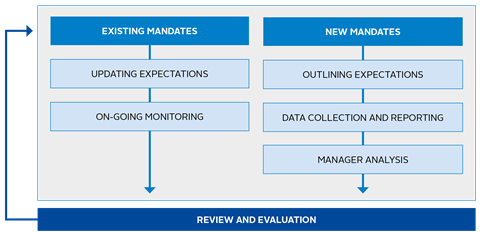
These approaches will inevitably overlap and interact. For example:
- The design of a new mandate may influence or result in a review of existing mandates or relationships.
- The approach taken may be influenced by the size of AUM. Smaller asset owners may use pooled funds more regularly and have few, if any, new separate mandates.
- Reviews of investment objectives and expected returns may result in changes to asset allocations and the subsequent design of new mandates.
- Managers may be appointed more regularly for pools of assets that are growing than asset pools that have entered into a distribution phase.
Existing mandates
Based on our interviews, segregated mandates, IMAs and legal documentation often last for more than five years. During this period, an asset owner’s responsible investment policy may evolve and new priorities could emerge, requiring reviews and updates of existing mandates. This process can be implemented in two steps: updating expectations and ongoing monitoring.
Updating expectations
The asset owners and consultants interviewed reported that once IMAs or investment mandates were agreed they were rarely updated. There was a consensus that more frequent reviews would be a healthy and valuable step, but this was accompanied by an acknowledgement that updating expectations may have additional cost implications. Rather than rewriting a legacy IMA or mandate, many asset owners find it more efficient to signal a change in direction by issuing formal ESG guidelines or reporting expectations to the investment manager. Japan’s Government Pension Investment Fund (GPIF) and CalPERS in the US provide two publicly available examples of updating expectations.
GPIF requires its external asset managers to adopt its Stewardship Principles on a comply or explain basis, including, for example, requirements that asset managers should:
- Develop a supervisory system through such measures as appointing independent directors to enhance their independence and transparency.
- Commit sufficient internal resources to fulfil their stewardship responsibilities effectively.
- Explain how remuneration and incentive systems for their executives and employees are aligned with the interests of GPIF.
- Ensure that their stewardship policy and activities contribute to long-term risk-adjusted returns rather than short-term outcomes, and formulate engagement objectives and plans.
- Conduct proper due diligence on third-party providers of engagement services, such as proxy voting.
- Determine critical ESG issues and specify goals that they would like to achieve as a long-term investor, and proactively engage with investee companies on these issues.
CalPERS’ objective was to ensure that 100% of investment decision-making policies and processes reflect relevant ESG considerations. Key performance indicators relating to this objective included requirements for all managers to:
- have policies and procedures for including ESG information in decision-making;
- establish and implement documented procedures for due diligence, contracting, and monitoring activities across all asset classes.
For example, CalPERS Real Assets Unit (RAU) scores each new investment proposal using a two-part standardised Manager Assessment Tool, which includes ESG-specific criteria. ESG questions are incorporated into the due diligence questionnaire (DDQ) for real assets and responses are included in the overall manager evaluation.
Memoranda recommending managers to the Real Assets Investment Committee include discussion of managers’ ESG practices and an alignment-of-interest analysis. Where the RAU has discretion regarding new investments, staff employs an ESG Consideration Matrix tool during due diligence to ensure that ESG factors are systematically considered.
When contracting external managers, the RAU seeks to include language in contracts that ensure long-term sustainability or ESG factors are included in assessment of assets, client reporting and a rolling sustainability performance survey.
Ongoing monitoring
Updating expectations is usually accompanied, or pre-dated, by evolving data reporting requirements for ongoing monitoring. Though unusual, some asset owners specify reporting requirements within their IMAs. The PRI Leaders’ Group provides a framework for leading practice in monitoring existing managers.
PRI Leaders’ Group – monitoring
In 2019, the PRI Leaders’ Group included asset owners that are leaders with respect to selecting, appointing and monitoring asset managers. Leadership characteristics of these asset owners included frequent monitoring of managers’ performance through on-site interviews, calls and DDQ reviews combined with rigorous follow-up procedures. Leaders set their own minimum criteria for evaluating manager performance.
They particularly distinguish themselves by reviewing and evaluating evidence of how ESG materiality has been evaluated by the manager and how ESG incorporation has affected investment decisions and portfolio returns. Some also monitor changes to who is overseeing, and who is responsible for, implementing ESG considerations.
Our interviews with asset owners produced interesting examples of manager-monitoring practices and reporting at BVK (Germany) and the state of Illinois (US). BVK is Germany’s largest pension fund, managing 12 pension schemes for professionals in a variety of sectors, including physicians, lawyers and artists. It prioritises manager reporting requirements (especially TCFD reporting) when designing mandates so that its external managers contribute to the fund’s own climate analysis. BVK is undertaking a process of classification for each asset class with specific key performance indicators, including, for example, GRESB[7] data for direct real estate investments.
The Office of the Illinois State Treasurer requires four documents from investment managers to aid ongoing monitoring: sustainability due diligence questionnaire, including applicable ESG policies; proxy voting policy; diversity, equity and inclusion report; and a proxy voting statistical report. The final item provides a picture of voting patterns by issue, and percentage supported/voted against compared with management’s recommendation.
Once expectations are updated and monitoring is in place for existing mandates, asset owners are able to review and evaluate investment managers. This step is common to existing and new mandates and will be covered in a later section.
New mandates
For most asset owners, new mandates are awarded infrequently, creating fewer opportunities for ESG incorporation than existing mandates. For new mandates, our interviews showed that some asset owners include formal expectations in requests for proposals (RfPs) as well as optional features or targets. These features must reflect the objectives of a responsible investment policy, fiduciary responsibilities and investment objectives. From our interviews we identified three separate steps towards integrating ESG into new investment mandates:
- Outlining expectations
- Data collection
- Manager analysis
Outlining expectations
Our research shows that minimum responsible investment expectations or standards are increasingly commonplace within new investment mandates. These can be based around essential or optional requirements and measured using qualitative and quantitative metrics. The PRI has introduced a set of minimum standards for PRI membership (see Figure 4). These standards provide an example signatories might use to set minimum standards for investment managers.
Figure 4: PRI minimum membership requirements
In 2018, the PRI introduced minimum requirements for PRI membership. Existing and future asset owner and investment manager signatories who fail to meet these requirements over a two-year period, following extensive engagement with the PRI, will be delisted.
These minimum standards included metrics around responsible investment policy, senior-level responsibility and internal resourcing. These metrics were measured using relevant sections within the Reporting Framework. They were intended to work alongside a programme of education for signatories who were identified as potentially failing to meet these standards. There is also an intention to develop these standards over time. The current and proposed requirements are outlined below.
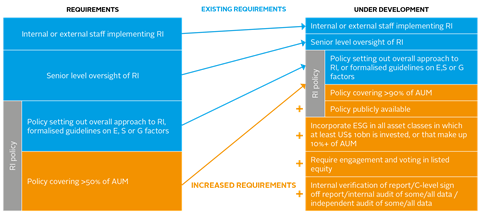
Figure 5 categorises additional approaches to minimum standards or expectations discussed during the interviews.
Figure 5: Examples of asset owner expectations or minimum standards
| Follow best practices |
|
||
| Adopt relevant policies |
|
||
| Report on ESG factors |
|
Anecdotal evidence from the interviews indicated that asset owners employ these standards to require asset managers to show intent and positive impact. For example, New Zealand Super stated “we are looking to move towards requiring all of our relevant investment managers to demonstrate conscious and measurable effort to societal and environmental benefit as a minimum requirement. This is still in its infancy, however we plan to have this rolled out over the next 12 months.”
Data collection
Earlier we shared the PRI Leaders’ Group framework for monitoring existing managers. When selecting new managers, the PRI Leaders’ Group has also developed best practices for data collection and manager analysis.
PRI Leaders’ Group - selection
Signatories in the Leaders’ Group embed assessment of potential managers’ ESG approach throughout the evaluation process. Leaders communicate their responsible investment strategy through documentation such as RfPs, RfIs or DDQs. Information is collected through public sources, DDQs and conducting on-site visits. Topics covered during visits can include: investment strategy, capacity, governance, investment processes and how ESG factors are incorporated into investment valuation and decisions. Qualitative information is also collected, covering areas such as managers’ responsible investment beliefs, culture and policies. Quantitative information such as ESG scoring and ranking is used for comparisons and shortlisting. Most leaders require their investment managers to engage and vote on their behalf, and so also review engagement and voting policies, processes and outcomes.
Manager analysis
Investment mandates need to be practical and to allow asset owners to select service providers or asset managers able to fulfil mandate requirements. A well-designed investment mandate will support the steps involved in manager analysis and selection outlined in Figure 6. These are some of the key steps undertaken by our interviewees during the selection and analysis of managers.
Figure 6: Manager analysis
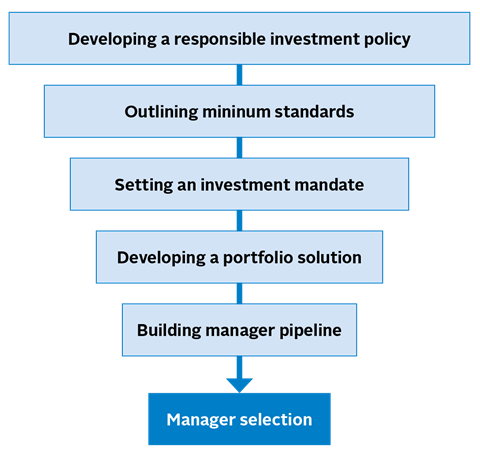
For new mandates this multi-year approach enables those involved in the selection process to identify a pipeline of asset managers that would constitute a high conviction list of candidates. These firms would offer strategies that are aligned with the asset owner’s responsible investment policies. How these approaches might differ between pooled and segregated mandates is discussed below.
Mandates for pooled and segregated portfolios[8]
Pooled or co-mingled funds
Evidence from the interviews indicated that selection of pooled funds depends on clear and consistent presentation of responsible investment policies and statements in the fund descriptions and IMAs. Experience shows these can vary and appropriate information may be presented in numerous places, including prospectuses, fund fact sheets, websites and periodic reports.
Segregated mandates
Evidence from the interviews and previous work shows the most common clauses incorporated into segregated mandate documentation cover exclusions and alignment with an asset owner’s responsible investment policy. Clauses covering issues such as alignment with the EU Taxonomy and the TCFD are less common. In the Reporting Framework a sizeable minority of respondents report that they include global guidelines such as the OECD Guidelines on Multinational Enterprises in documentation relating to segregated mandates.
Review and evaluation
Whether seeking new managers or revisiting terms with existing managers, review and evaluation is an important component of the asset owner-manager relationship. It is a process that reflects the dynamic relationship between an investment manager and asset owner – developing over time and subject to periodic reassessment.
This ongoing process enables asset owners to review the extent to which the investment manager meets the requirements laid out in the mandate and legal documentation. Some of the interviewees described a formal manager evaluation framework that categorised managers into different groups depending on policies and processes. These characteristics are covered in PRI’s guide on manager selection, which outlines leading practices among asset managers (see Figure 7).
Figure 7: Leaders’ Group core attributes for investment managers
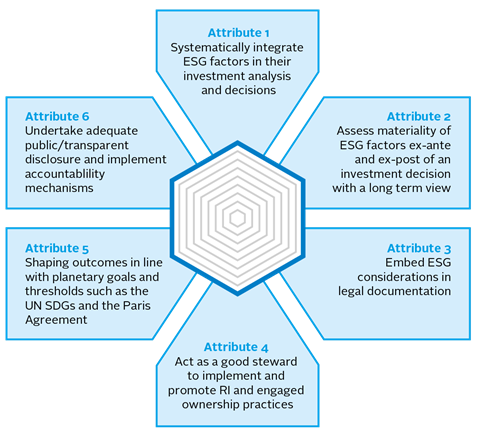
GPIF offers an example of a process that attempts to evaluate and identify leading asset managers.
Figure 8: GPIF’s approach to stewardship evaluation*
GPIF considers proxy voting and company engagement to be critical factors in evaluating managers. GPIF fully relies on external managers’ stewardship responsibilities for equity investments, both domestic and foreign. The fund tends to work with managers with a history of ESG engagement.
Stewardship is an important factor for GPIF when undertaking manager due diligence and monitoring (10% weighting for ESG/stewardship in active manager searches and 30% in passive).
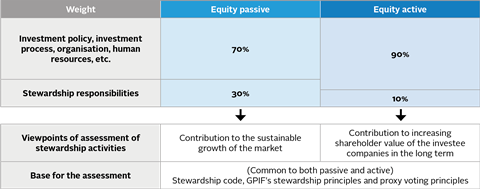
*Source: GPIF Stewardship Activities Report 2020-2021
The relationship between an investment manager and asset owner inevitably develops over time and is subject to periodic review and reassessment. Based on feedback gathered during interviews, we identified two broad metrics used by asset owners to assess investment managers:
- Evaluation: Measures the success against expectations laid out in a mandate.
- Conviction: Reflects the asset owner’s faith in the manager’s ability to deliver against expectations in the future.
Putting these metrics into a framework can help asset owners compare asset managers and assess their ability to successfully fulfil an investment mandate (see Figure 9). The resulting assessment might enable asset owners to decide the appropriate course of action to take with specific managers. For example, an asset owner might engage with an asset manager that has a low ESG evaluation if the asset owner also has a high conviction in the manager.
Figure 9: Review framework – evaluation/conviction matrix
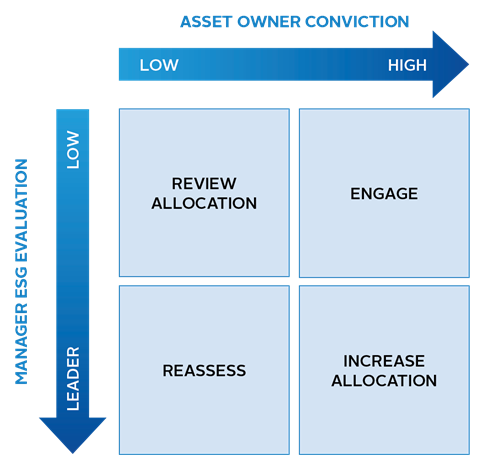
Sustainability outcomes
The steps above can help to embed responsible investment criteria into mandate development and the manager selection, appointment and monitoring process. Our interviews showed asset managers are at various points on this journey. To be able to assess sustainability outcomes, some have stepped back to take a more holistic view of the process. Evidence from the signatories and AUM flows[9] shows asset owners and beneficiaries are increasingly interested in sustainability outcomes. Research for this paper confirmed the trend, with investment consultants reporting increased enquiries on how to incorporate sustainability outcomes into investment strategies and mandates. These interviews outlined three types of connected activities asset owners are taking to align sustainability outcomes with investment mandates.
A. Learning and measuring
Asset owners are increasingly interested in how to align mandates with the SDGs and how to measure the impact of portfolio holdings. Asset owners remain in an exploratory phase that involves:
- developing mechanisms to incorporate the SDGs into key performance indicators;
- measuring portfolio positive and negative outcomes;
- comparing over time or against peers.
Initial steps undertaken by a number of interviewees include portfolio reviews or benchmarking, while others were starting to consider both negative and positive sustainability outcomes.
B. Target setting
Target setting was frequently mentioned in interviews. Regulatory developments, such as the EU’s Sustainable Financial Disclosure Regulations (SFDR), have encouraged reporting on specific issues or performance against targets. Targets relating to climate, such as net zero commitments, were most common and were adapted to reflect different investment strategies or asset classes.
C. Promoting outcomes
Investors seeking a specific sustainability outcome can pursue dual strategies:
- Intentionally allocate capital in ways that help achieve the outcome.
- Engage collaboratively or individually with investees, policy makers and regulators.
The development of mandates to promote a sustainability outcome remains unusual, though some interviewees mentioned integration of the SDGs. Some asset owners argued that investing in private markets was potentially a more meaningful mechanism to improve sustainability outcomes. New York City offers an example of a multi-asset class search for funds and products aligned with UN SDG 13/climate action.
The New York City Comptroller serves as investment advisor, custodian and trustee to the New York City Retirement Systems (Systems) which have over $250 billion AUM as of June 2021. The Comptroller and numerous trustees of the Systems stated a goal in September 2018 to double their investments in climate change solutions within three years across the portfolio in private and public markets. By early 2021, they exceeded this goal by more than tripling their climate solutions investments from approximately $2 billion to over $6 billion in allocations and commitments.
The Systems outlined a clear process for incorporating climate related issues into mandate design and manager searches. Across all asset classes, managers should include an active approach to identifying climate solutions and an ability to measure and monitor the portfolios’ exposure to climate change solutions. The Systems provide a clear taxonomy on the meaning of climate change solutions (business activity and percentage of revenues). Climate change solutions also extend to businesses that help to facilitate the transition to a low carbon economy consistent with Paris Agreement goals. In public equity and fixed income, the Systems issued a public search for actively managed strategies that outline climate solutions criteria along with other investment criteria, including a range of benchmarks consistent with the Systems’ policies and asset allocations. For climate solutions mandates in all asset classes, the Systems ensure meeting risk-adjusted market rate returns consistent with other investments, investment policy objectives and asset allocations.
Challenges
Key messages:
- Asset owners face a variety of challenges when seeking to integrate ESG risks and sustainability outcomes in investment mandates.
- These challenges include benchmark selection, fiduciary duty, transparency, track record and fund structure.
Our interviews highlighted a range of challenges when integrating ESG risks and sustainability outcomes into the design of investment mandates.
Figure 10: Challenges*
| CHALLENGES | |
| ESG performance and risk attribution |
|
| Fiduciary considerations |
|
| Improved levels of transparency |
|
| Sufficient length of track record |
|
| Pooled or co-mingled funds offer limited flexibility |
|
| Benchmark selection |
|
| Insufficient educational collateral |
|
* For more information on fiduciary duty and the regulatory environment, see the following PRI publications: A legal framework for impact and Fiduciary duty in the 21st century final report. Also, from Morgan Lewis: The Regulatory Overlay on ESG Investing. For more information on ESG factors in voting, see the PRI’s Making voting count: principle-based voting on shareholder resolutions.
Next steps
This report maps out some of the common approaches, challenges and solutions for asset owners seeking to integrate responsible investment criteria into investment mandates. Informed by this report and discussions with the PRI’s Asset Owner Technical Committee, we have outlined two possible next steps.
1. Encourage and facilitate alignment of approaches to developing investment mandates
Currently only a small number of asset owners incorporate both formal responsible investment practices and sustainability outcomes in their investment mandates. Often these approaches are ad hoc due to resource constraints and other barriers.
Findings from the interviews and feedback from the advisory committee have identified the need for an entity, body or process to co-ordinate or standardise approaches to the incorporation of ESG into mandate design. This could help both large and small asset owners increase leverage with asset managers to incorporate ESG issues and sustainability outcomes into portfolio construction.
2. Promote awareness among key stakeholders
Asset managers and investment consultants are key stakeholders in incorporating responsible investment policies and practices into investment mandates. A list or statement of expectations or minimum standards could help these stakeholders clearly understand asset owner priorities, while asset owners acting as a consortium could also improve uptake.
If readers have any questions or comments relating to this report, please contact us at [email protected].
Common Approaches
1. Please describe your overall process for designing investment mandates i.e. from policy goals to SAA to structure.
- Where, if at all, does ESG fit into the overall approach?
- Is your focus mainly on public equity or do you include ESG in designing mandates for other asset classes i.e. fixed income or multi-asset mandates?
- Do you make adjustments for asset classes/sub-sectors where ESG data is less developed/readily available (e.g. securitized products)?
- What specific ESG goals do you hope to achieve through designing investment mandates?
2. Do you have a formalised way of communicating to prospective managers and the public about new mandates that include ESG requirements?
3. Please walk us through the process of designing a mandate plan and who the important decision-makers are within your organisation.
4. The below questions are focused on the Sustainable Development Goals (SDGs). If applicable, please answer the following:
- Do you assess the negative and positive real-world outcomes towards the SDGs across your entire portfolio?
- Do you set targets to reduce the negative and/or enhance the positive real-world outcomes towards the SDGs in designing your investment mandates?
- Do you monitor the performance and/or measure progress of your external mandates/pooled structures on realizing these real-world SDG outcomes?
5. How do you align your mandate design process to your manager due diligence, evaluation, and monitoring processes?
- Do you mandate any minimum ESG requirements in your investment manager searches i.e. PRI signatory, ESG formal training programs, frequency of ESG/impact reporting, climate footprinting, or alignment with UN Guiding Principles on Human Rights?
- What ESG data points do you gather solely for information purposes? Do you expect managers to provide information from the past year or are you willing to accept longer-term data points, i.e. a 3-year-old case study?
6. Have you conducted, or do you intend to conduct, any searches (RFP or RFI) for dedicated ESG strategies? If so, please describe how you defined a dedicated ESG strategy and the process you followed/planned to follow.
- Did you include any Minimum Qualifying Requirements such as AUM, length of track record, diversity, and team tenure?
- Would you be willing to consider non-ESG labelled strategies in a category with a sufficient number of options of dedicated ESG strategies?
- What ESG requirements are you willing to forgo when onboarding a manager with the intention of engaging with the manager on the particular issue at a later stage?
Challenges
7. What gaps have you identified in your analysis, data, or advice to more systematically include ESG in designing investment mandates?
Next steps
8. Can you think of any tools or guidance that would help encourage your peers to more formally and systematically adopt ESG issues in investment mandates? How could PRI help?
9. What is the best piece of advice you have received on the integration of ESG into mandate design? If you were to supply one piece of advice to a peer (another asset owner) about starting to think about incorporating ESG into mandate design (ESG or non-ESG specific) what would that be?
Downloads
References
[1] See Global ESG Flows | Morningstar.
[2] See PRI Leaders’ Group 2019, PRI SAM webinar summary, PRI Investing with SDG Outcomes and Reporting Framework.
[3] See PRI Manager selection and Reporting Framework.
[4] See PRI Investing with SDG Outcomes and Reporting Framework.
[5] See PRI Regulation database.
[6] See PRI 2020 Listed Equity Snapshot and Reporting Framework.
[7] See The Global ESG Benchmark for Real Assets.
[8] See PRI Data Portal and Reporting Framework.
[9] See Global ESG Flows | Morningstar, PRI Data Portal.3



